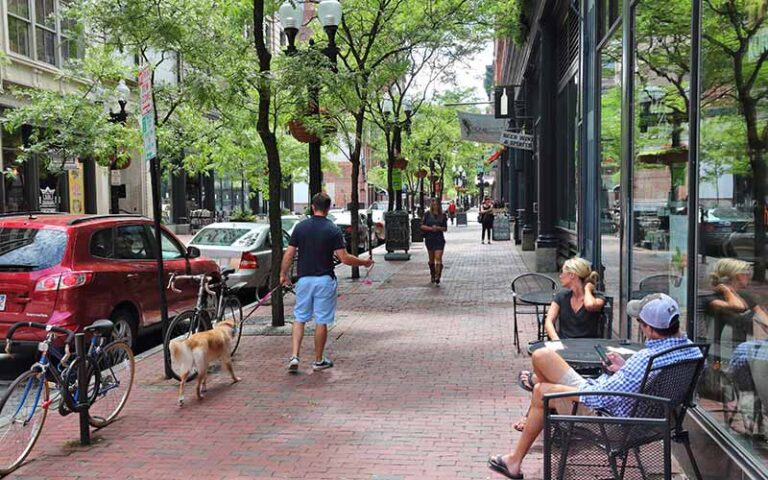I’ve been writing about home design and neighborhood planning for years now, and there’s one thing that keeps coming up in my research: trees make a huge difference in how good a place feels to live in.
It’s not just about looking pretty (though they definitely do that).
Trees work like neighborhood superheroes, doing all sorts of amazing things that many people don’t even notice.
When I walk through a tree-lined street versus a bare one, I can feel the difference right away.
The air seems fresher, it’s cooler on hot days, and there’s this sense of creating calm that’s hard to describe but very real.
The houses even look more like homes when they’re nestled among greenery.
So I thought we should chat about all the ways trees make suburban neighborhoods better places to live, and maybe inspire you to appreciate the ones you have or plant some new ones!
10 Tips How Trees Shape Liveability in Suburban Neighbourhoods
Trees aren’t just pretty decorations for our right neighborhoods.
They’re working 24/7 to make our living spaces healthier, happier, and more valuable.
From cleaning the air we breathe to keeping our streets cooler in summer, trees pull off some pretty amazing tricks.
Plus, they connect us to nature right outside our front doors.
Let’s take a closer look at what these leafy neighbors do for us every day.
Enhancing Air Quality
Trees are like nature’s air filters.
They grab dust, smoke, and other yucky stuff from the air before it gets into our lungs.
One big oak tree can suck up about 5,000 gallons of water each year and release it as clean water vapor.
At the same time, that tree is taking in carbon dioxide and giving us back oxygen.
The really cool thing is how they catch those tiny pollution particles on their leaves.
Next time you’re near a busy road, notice how trees along the street collect dark dust on their leaves.
That’s pollution that would have gone into your lungs instead!
In suburban areas with lots of cars coming and going, having trees along streets can cut air pollution by up to 60% on that street.
That’s why older neighborhoods with big trees often feel so much nicer to breathe in.
Your lungs will thank you for those trees!
Reducing Urban Heat Island Effect
Ever notice how some neighborhoods feel like ovens in summer while others stay cool? That’s partly because of trees! Without trees, sun beats down on roads, sidewalks, and buildings, heating them up like giant radiators.
This creates what experts call the “heat island effect” where built-up areas get much hotter than natural areas.
Trees fight this problem in two super smart ways.
First, they create shade that keeps surfaces cooler.
A shaded sidewalk can be 20-45 degrees cooler than one in full sun! Second, trees release water vapor from their leaves in a process called “transpiration,” which cools the air just like sweat cools your body.
In neighborhoods with good tree cover, summer temperatures can be 6-8 degrees cooler than treeless areas nearby.
This doesn’t just make walking the dog more pleasant—it cuts air conditioning costs by 15-35% and helps prevent heat-related health problems.
Supporting Mental Health and Well-being
Trees aren’t just good for your body—they’re good for your brain too! Research shows that just seeing trees from your window can help lower stress and anxiety.
People living in green neighborhoods report feeling happier and more satisfied with their lives.
There’s something about the gentle movement of leaves in the breeze that calms our nervous systems.
Hospital patients who can see trees from their windows even recover faster and need less pain medication than those looking at buildings.
Kids growing up around trees tend to have better focus and fewer ADHD symptoms.
For adults, a quick walk under a tree canopy can lower blood pressure and improve mood almost immediately.
It’s like trees give our overstimulated brains a chance to reset and breathe.
Pretty amazing for something that’s just standing there looking pretty, right?
Encouraging Outdoor Activity
When streets have trees, people use them more. It’s that simple.
Tree-lined paths invite us to walk, jog, bike, or just hang out outside space.
Nobody wants to exercise on a hot, sunny street with no shade, but add some trees and suddenly that morning walk feels inviting.
Kids play outside more in neighborhoods with trees too.
They provide natural climbing structures, shade for games, and a sense of adventure that sterile playgrounds sometimes miss.
Even simple games become more fun when there are trees to hide behind or leaves to jump in.
For older folks, shaded streets make daily walks possible even in summer.
Trees create natural rest spots where people can pause in the shade.
This isn’t just about fun—it’s about health.
Neighborhoods with good tree cover have higher physical activity levels across all age groups, which means healthier residents.
Boosting Biodiversity
A single mature oak tree can be home to hundreds of species! Trees in our neighborhoods bring nature right to our doorsteps by creating mini-ecosystems.
Birds nest in branches, squirrels leap from tree to tree, butterflies visit flowers, and countless bugs find homes in bark and leaves.
This matters because connected patches of trees create “wildlife corridors” that let animals move safely through suburban areas.
Without these green connections, wildlife gets trapped in isolated pockets.
Having diverse tree species is key.
Different trees support different animals and insects.
Native trees are especially valuable since local wildlife evolved alongside them.
The morning bird chorus that makes your neighborhood feel alive? You can thank your trees for that.
Services such as Gold Coast Tree Lopping ensure that trees remain assets rather than liabilities by keeping them healthy and safe while preserving their wildlife benefits.
Improving Stormwater Management
Trees are amazing at handling rain.
When storms hit treeless neighborhoods, water rushes across hard surfaces, causing flooding and carrying pollutants into waterways.
Trees change this pattern completely.
Their canopies catch rainfall first, slowing its journey to the ground.
Some water evaporates right off the leaves, never reaching the soil.
What does reach the ground gets absorbed by tree roots, which act like straws drinking up water.
One medium-sized tree can catch over 2,000 gallons of water per year! Tree roots also create channels in soil that let water soak in faster.
In neighborhoods with good tree cover, stormwater runoff decreases by 35-50%.
This means less flooding, less erosion, cleaner waterways, and less strain on stormwater systems.
The best part? Trees do this work for free, 24/7, while also looking beautiful and providing all those other benefits we’ve talked about.
Increasing Property Values
Want to boost your home’s value? Plant a tree! Houses on tree-lined streets sell for 3-15% more than the same houses on treeless streets.
Buyers consistently pay premium prices for properties with mature trees.
It makes sense when you think about it.
Trees make homes look established and cared for.
They frame houses beautifully and create a sense of privacy.
The cooling effect of trees cuts energy bills, another selling point for smart buyers.
Real estate agents know this well.
That’s why “tree-lined street” appears in so many property listings.
Neighborhoods with tree-planting programs often see property values rise across the board.
And unlike property renovations that go out of style, trees actually increase in value as they grow and mature.
Strengthening Community Identity
Trees help create places that feel special.
Think about famous neighborhoods you know—chances are, many are known for their tree-lined streets or special tree features.
Trees become landmarks that help define a place.
When communities plant and care for trees together, it creates social bonds.
Neighbors meet while watering new street trees or raking leaves.
Tree planting events bring people together across generations and backgrounds.
Many suburbs find that their trees become part of their identity and source of pride.
Streets with distinctive tree patterns gain character that new developments often lack.
People feel more connected to places with history, and mature trees are living links to a neighborhood’s past.
Reducing Noise Pollution
Trees are natural sound barriers.
Their leaves, branches, and trunks absorb and scatter sound waves, cutting noise levels from traffic, construction, and other urban sounds.
A belt of trees and shrubs can reduce noise by 5-10 decibels—about half as loud to our ears.
The soft surfaces of leaves and soil absorb sound instead of bouncing it back like hard surfaces do.
For homes near busy roads, strategic tree planting can make a huge difference in how peaceful the property feels.
Even when trees don’t completely block noise, the natural sounds they create—rustling leaves, bird songs, wind in branches—mask unpleasant mechanical noises with calming natural ones.
Promoting Long-Term Sustainability
Trees work harder the older they get.
A newly planted sapling helps a little, but a 50-year-old tree does hundreds of times more good.
This means the trees we plant or protect today become more valuable with every passing year.
In a world where so many things become obsolete quickly, trees increase their value over time.
They clean more air, catch more water, create more habitat, and provide more beauty as they grow.
The most sustainable neighborhoods plan for tree succession—planting young trees before older ones decline.
Without this planning, neighborhoods can lose their tree canopy in a single generation when all trees reach old age together.
Tree diversity is key to sustainability too.
Neighborhoods with many different tree species stay resilient against diseases, pests, and changing conditions.
When we invest in trees, we’re investing in a better future for the people who’ll live in our neighborhoods long after we’re gone.
Conclusion
Trees do so much more than just look pretty in our suburban neighborhoods.
They clean our air, cool our streets, lift our spirits, boost our property values, bring wildlife to our yards, handle stormwater, cut noise, and build stronger communities.
Not bad for something that stands in one place its whole life!
If you’re lucky enough to have trees on your property or street, take a moment to appreciate what they’re doing for you every day.
And if your neighborhood lacks trees, consider getting involved in planting efforts.
Even one new tree makes a difference, and that difference grows every year.
The neighborhoods we love most are almost always the ones with the best trees.
That’s no accident.
Trees shape liveable places in ways both obvious and invisible, working quietly in the background to make our suburban lives better.



